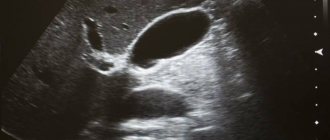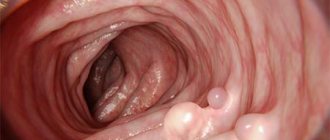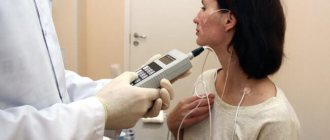One of the main causes of hemorrhoids is constipation, which leads to congestion in the pelvis. Often, fecal retention occurs during treatment of the disease, even when the patient adheres to a special diet. Difficulty defecating is accompanied by pain, flatulence; hard feces can injure the rectal mucosa, which significantly increases the risk of complications. To quickly cleanse the intestines, the patient is prescribed an enema for hemorrhoids, which is also required to be given to the patient before surgery.
In what cases are enemas prescribed for hemorrhoids?
Many patients are interested in the question of whether it is possible to do an enema for hemorrhoids, because they are afraid of further injuring the damaged rectal mucosa. Proctologists say that bowel cleansing can be done for diseases of varying severity, but taking into account careful insertion of the tip into the anal canal to prevent injury to the hemorrhoids.
Colon cleansing with an enema is also used on the eve of instrumental examination of the rectum to determine the severity and location of hemorrhoids
An enema for hemorrhoids is indicated for patients in the following situations:
- rapid cleansing of the intestines from feces;
- before diagnostic procedures on the rectum;
- in the postoperative period.
Patients with hemorrhoids very often suffer from constipation, which contributes to constant pressure in the abdominal cavity. So, after the act of defecation, bleeding may occur, which occurs against the background of injury to the mucous membrane of the rectal canal by solid feces. In this situation, a cleansing or therapeutic enema will help the patient clear the intestines of hardened feces. Enemas help quickly and effectively eliminate fecal impaction during constipation, however, if there are constant problems with stool, they are not recommended for constant use.
Cleansing the digestive tract from feces using an enema is prescribed in the postoperative period in connection with the removal of hemorrhoids. To quickly restore the connective tissue of the rectum, the patient is prohibited from straining the anal area. Therefore, to speed up regenerative processes and reduce pain after defecation, oil enemas are prescribed.
The procedure for cleansing the intestines must be carried out if other methods in the fight against constipation are ineffective (diet therapy, gymnastic exercises, medications). The enema is carried out as prescribed by the doctor and exclusively in the remission stage of hemorrhoids.
Treatment of hemorrhoids after childbirth
Unfortunately, almost every woman in the postpartum period faces such a problem as hemorrhoids. It usually occurs due to excessive tension in the muscles of the perineum and stretching of the hemorrhoidal veins during the pushing of the woman in labor. It has been noted that the development of hemorrhoids can begin during pregnancy, which is facilitated by weight gain and a sedentary lifestyle. In this regard, it is recommended to carry out regular prevention of hemorrhoids both during pregnancy and in the postpartum period. Often it is pregnancy and childbirth that become the very catalyst that provokes the development of hemorrhoids. And there are a number of reasons for this.
Causes of postpartum hemorrhoids
Firstly, during pregnancy (usually in the second and third trimester) and especially during childbirth (of course, if they occur naturally), the pressure of the enlarged uterus and fetus on the rectum becomes simply colossal, while blood flow to these places becomes much more difficult. When pushing, the sphincter muscles experience particular overload. This also includes intra-abdominal pressure, which is increased in most pregnant women in the later stages, not to mention situations where there is a multiple pregnancy.
Quite often, a pregnant woman may have only minor symptoms, but during childbirth, when intra-abdominal pressure rapidly increases, nodules and fissures can form. The severity of the lesions in this case depends on the individual characteristics of the woman in labor, the weight of the child, and the course of labor.
Frequent constipation can also provoke the appearance of hemorrhoids, which, alas, is not at all uncommon in pregnant women. This is due, first of all, to an increased amount of progesterone - the so-called pregnancy hormone, which can cause various kinds of digestive disorders, and also contribute to a slight weakening of the tone of the walls of blood vessels, which is fraught with more severe stretching of them, and mild intestinal atony. As a result of the described changes, the digestive process in a pregnant woman becomes slower, thereby causing constipation. Constipation, in turn, increases pressure on the rectum and contributes to blood stagnation. This results in the appearance of characteristic hemorrhoids (pictured).
Among other reasons leading to the formation of hemorrhoids, one can also highlight nutrition with foods that contain insufficient amounts of fiber, excess body weight (not only during pregnancy, but also before and after it), bad habits (smoking and alcohol), constant sedentary work, lifting heavy objects without proper training, as well as the use of hormonal drugs, which are often prescribed by doctors for complicated pregnancies. Therefore, it is advisable to think about all this even before pregnancy and childbirth.
It is especially worthwhile to be attentive to those women whose families have relatives who were or are suffering from hemorrhoids. In this case, there is a high probability that insufficient elasticity of the veins and, as a result, the risk of developing hemorrhoids, is a hereditary trait in your family.
Characteristic signs of hemorrhoids
At the very beginning of the development of the disease, at its first stage, characteristic signs indicating the presence of hemorrhoids are:
- discomfort in the rectum (pain, heaviness, itching, burning);
- the presence of blood in the stool after defecation;
- increased body temperature;
- general malaise;
- signs of intoxication of the body.
Subsequently, as the rectal veins enlarge, peculiar “bumps” or hemorrhoids are formed, which were mentioned just above. Their appearance is characterized by the second stage of the disease. All this is accompanied by pain (sometimes very pronounced) and inflammation. Particularly painful and prone to complications are internal hemorrhoids , when the nodes are located inside the anal canal. External hemorrhoids , despite their unesthetic appearance in terms of pain and complications, cause less trouble.
The second stage during pregnancy can persist for a fairly long period of time, however, undetected and untreated hemorrhoids during childbirth can progress to the next, third stage, which is characterized by the prolapse of nodes from the anus. If appropriate measures are not taken in time, the disease will progress to the last fourth stage, when it is almost impossible to move the hemorrhoids inward manually; they significantly increase in size, constantly bleed and become inflamed.
What are the dangers of hemorrhoids after childbirth and how to deal with this problem correctly?
You should know that hemorrhoids can occur not only during pregnancy, but directly during childbirth. Be that as it may, in the postpartum period, hemorrhoids can make the body even more vulnerable than usual. Therefore, it is so important to monitor your health so as not to trigger the development of the disease and promptly seek help from a specialist. It is known that after pregnancy and childbirth, a woman’s immune system needs some time to fully restore the body’s defenses. During this period, a disease such as hemorrhoids, for example, can only weaken them further. Let's add here the problems of caring for a child and breastfeeding him. Indeed, when the disease worsens, the bleeding that occurs in a young mother can contribute to infection with dangerous infections. There is also a high probability of developing anemia, paraproctitis, thrombophlebitis, and even necrosis of the external hemorrhoid when it is pinched. In addition, we should not forget that, based on numerous medical studies, hemorrhoids are recognized as one of the indirect causes of cancer. This should be taken into account by all those who consider hemorrhoids to be a minor disease that should not be paid attention to. Hemorrhoids will not go away on their own; they must be treated! Experienced proctologists at the ViTerra .
In the postpartum period, treatment of hemorrhoids is usually extremely gentle. Even at the third or fourth stage, when treatment of external hemorrhoids is already necessary, if the patient’s condition allows it, they try to postpone the time of surgical intervention to a later date.
What can help reduce the symptoms of the disease?
Typically, hemorrhoids after childbirth occur in an acute form: first there is itching, burning, discomfort, and a feeling of heaviness in the anus. Over time, the pain increases more and more, bleeding appears during the act of defecation, which can provoke anemia, which is especially undesirable for a woman after childbirth. Hemorrhoids increase significantly in size and they fall out. Every movement for a woman turns out to be very painful, it is difficult for her to walk, sit, even the act of defecation becomes extremely painful. The anal area becomes inflamed and cracks appear. In this case, immediate treatment is necessary.
- The first step is to improve your diet. This will not only ease the course of hemorrhoids, but will also be beneficial for the child, especially if the woman is breastfeeding.
- You can and should use local remedies that can cure hemorrhoids at home. Herbs, decoctions, tinctures - all of this can be used as external remedies for hemorrhoids.
- It is also worth making sure that you do not remain in an upright or sitting position for a long period of time. It is advisable to find at least a few minutes a day for special gymnastics, which helps strengthen the muscles in the pelvic area.
- Any medications should be taken with extreme caution. If your baby is breastfed, do not take any medications without first checking with your doctor. Only a qualified specialist will be able to prescribe medications that will not pass into your baby’s milk and, therefore, will not cause harm to his body.
- You should also be careful when using laxatives, which are often recommended for hemorrhoids. For pregnant and lactating women, such drugs are strictly contraindicated.
- Make an appointment with a proctologist at clinic No. 1 ViTerra Belyaevo, and then you can be sure that your health and the health of your baby are completely safe! The doctor will conduct an examination and prescribe you appropriate treatment, including the use of suppositories, ointments or tablets for hemorrhoids, recommend you a proper diet rich in fiber and avoid the problem of constipation, and also suggest walking more and doing a number of exercises to strengthen the pelvic muscles. Remember that if you have any suspicions about hemorrhoids, you should avoid wearing tight underwear, do not lift heavy objects, and do not put off visiting a specialist.
Prevention of hemorrhoids after childbirth
Prevention of hemorrhoids is an effective technique that, if it does not help to completely avoid postpartum hemorrhoids, will at least prevent its severe course. Such preventive measures should be carried out during pregnancy.
1. Women who are expecting a baby are advised to carefully monitor their diet to avoid constipation and other problems.
2. They should diversify their diet with natural food, fresh vegetables and fruits. Coffee, chocolate, pastries and fatty foods are best avoided. You should also avoid spicy foods, which can irritate the rectal mucosa, and legumes, as they cause severe gas formation.
3. When preventing hemorrhoids, the correct daily routine is considered very important. It is recommended to visit the toilet at the same time, preferably in the morning. During bowel movements, you should not push too hard so as not to provoke swelling of the hemorrhoidal veins. In addition, it is very important to maintain personal hygiene. Doctors advise that after each bowel movement, wash yourself with clean, cool water and wipe the anal area dry with soft toilet paper or a towel.
4. An important point in the prevention of hemorrhoids, especially postpartum, is physical activity. Despite the fact that heavy loads are contraindicated for pregnant women, light exercises will only benefit them. In addition, pregnant women are advised to walk a lot in the fresh air, which will not only help prevent hemorrhoids, but also strengthen the immune system.
5. Another method of prevention is Kegel exercises . Their essence is to alternately tense and relax the muscles around the anus and vagina. If you perform such exercises regularly, you can prevent not only postpartum hemorrhoids, but also uterine prolapse and laxity of the vaginal muscles.
As a parting word
We wish each of you that your postpartum period will be filled only with the most wonderful moments and joyful worries about your baby growing up every day, and not with sad thoughts and worries about how to independently cope with alarming symptoms that indicate the development of hemorrhoids.
Don’t let the disease get worse, love yourself and be extremely careful and attentive to the issue of maintaining your own health and, as a result, the health of your baby!
Types of cleaning procedures
To cleanse the intestines with hemorrhoids, there are 4 types of enemas, which have different indications and techniques:
- hypertensive;
- cleansing;
- oil;
- medicinal.
Enemas for hemorrhoids involve the rectal route of drug administration; the active substances quickly penetrate the bloodstream without causing a negative effect on the liver. An enema not only has cleansing properties, but also serves as a good prevention of concomitant pathologies of the rectum.
Features of performing an enema for hemorrhoids
The procedure for cleansing the intestines for venous pathology of the rectal canal should take into account the fact that chronic constipation often develops with the disease, in which the rectum is heavily clogged with feces. Therefore, to give the first enema you will need a small amount of liquid (350–450 ml).
The first procedure for cleansing the intestines is recommended to be carried out with a syringe.
For the procedure, boiled water or decoctions of medicinal plants are used; the temperature of the liquid for intestinal spasm should be cool. As the digestive tract is cleared of fecal stones, the intestines will hold a larger volume of liquid. In the future, it will be possible to give an enema using an Esmarch mug.
To reduce the risk of damage to hemorrhoids, insertion of the tip must be done with careful and slow movements. For the procedure, it is recommended to choose a tip made of rubber, since it is less traumatic than plastic. If an obstacle is formed during the insertion of the tip, it is necessary to immediately stop its advancement by opening a stream of water into the intestinal space.
In some cases, during an enema, an unpleasant burning sensation may occur in the rectal canal, this indicates the development of an inflammatory process that has disrupted the integrity of the rectal mucosa. As the intestines are cleansed of feces, inflammation decreases.
In case of hemorrhoids, before inserting the tip into the anus, it must be lubricated with petroleum jelly; also, to prevent injury to the anus, it is additionally lubricated with liquid soap.
Laxatives in preparation for a visit to the doctor
You need to properly prepare for a visit to a proctologist
If a democratic enema is for some reason impossible or the patient does not like the procedure, then you can turn to laxatives. Doctors recommend using either Microlax microenemas or Fortrans sachets.
How to use Microlax?
The drug is a capsule with a viscous white solution. The product contains sodium citrate, sodium lauryl sulfoacetate and sorbitol. The volume of one tube is 5 ml. Microlax is a combination drug. Its action is based on softening stool and increasing the volume of fluid in the intestines. The body cleansing process will begin in 15 minutes.
The drug is approved for use in children under 1 year of age and older, pregnant and lactating women. There is only one contraindication for this drug - individual intolerance to Microlax. How to administer the drug? It's simple:
- Open the tube
- Squeeze a drop of product onto the tip
- Insert the tip of the tube to its full length (for babies under 1 year of age, the tip is inserted halfway)
- Inject the drug and remove the tip
- After 15 minutes we enjoy the process of defecation
- The cleaning procedure with Microlax should be carried out 3 hours before your appointment with a proctologist.
The drug "Fortrans"
It is easier to prevent a disease than to treat it!
This medicine is used orally. That is, you drink a laxative solution and there is no need to torture your butt with an enema. Comfortable? Yes, but expensive, tasteless and long. And there are also a number of contraindications! The main active ingredient in the drug, macrogol 4000, has an osmotic effect. The package contains 4 sachets for preparing the solution. But in pharmacies they sell sachets individually. So for a patient weighing up to 80 kg, it is enough to purchase 2 sachets, if more than 80 kg, then you will have to drink 3 packets of laxatives.
Each packet should be dissolved in 1 liter of water. So, if the patient weighs 100 kg, then you will have to take 3 liters of solution. Preparation for the visit begins 12 hours in advance. That is, if you plan to take it in the morning, then you need to start drinking the solution in the evening of the previous day. Every 15 minutes you should drink 1 glass of solution. Thus, 2 liters of Fortrans will have to be drunk in 2 hours, 3 liters in 3 hours. After 1 hour, cleansing of the body begins and ends 2 hours after taking the last portion. Contraindications to taking Fortrans:
- Serious condition of the patient
- Intestinal obstruction or suspicion of this condition
- Rectal tumors of any etiology
- Inflammatory processes on the mucous membrane of the rectum and intestines in general
- Age up to 15 years
- Pregnancy is a relative contraindication. The question of taking this drug is decided by the attending physician
- Individual intolerance to the components of the drug
- Kidney diseases
Attention! Don't prolong the procedure! You’re supposed to drink 2 packets in 2 hours – so that’s what you need to do! And not 1 sachet in the evening, but 2 in the morning! The expected effect will not be achieved.
It may even have the opposite effect. Water will not leave the intestines, but it will not be absorbed or absorbed due to the drug dissolved in it. And the intestines will not be cleansed, and your belly will be full of water.
Enemas in the postoperative period
After radical surgery to remove hemorrhoids, when part of the rectum is cut off, the patient may experience constipation in the postoperative period, which is associated with intestinal atony. This complication is a consequence of the effects on the body of substances that are used for general anesthesia; they help relax smooth muscles, including the digestive tract.
Constipation after surgery is often psychological in nature, so oil-based enemas are used to eliminate it.
What enemas are used to treat constipation after surgery and what are their features? Treatment of postoperative stool retention is carried out using medicinal laxatives, which complement bowel cleansing procedures based on oil solutions. The procedure is carried out with a small volume of liquid in the amount of 60–110 ml. For rectal administration, use vegetable oils (olive, sunflower, sea buckthorn), preheated to room temperature. To easily cleanse the intestines, an enema is given before bedtime, the laxative effect occurs after 8 hours, and occurs the next morning.
The role of enemas in the treatment of the disease
One of the methods of treating hemorrhoids is an enema, the essence of which is to inject water and herbal solutions into the lower intestinal region.
As a rule, it is performed before examining the digestive tract to clean the rectum or in preparation for surgery.
The procedure is based on the introduction into the anal passage of compounds that have a therapeutic effect, eliminate the process of inflammation and normalize digestive function. Enemas also relieve swelling and irritation, and improve disinfection of the mucous membrane.
Types of solutions for therapeutic enemas
Enemas have a therapeutic effect, with the help of which solutions based on medicinal plants, oils and saline solutions are introduced into the intestines. Therapeutic enemas are usually called microenemas because a small volume of liquid, up to 100 ml, is injected into the intestines. If hemorrhoids are accompanied by constipation, then it is better to do cleansing procedures 30 minutes before the medicinal enema.
Alternative medicine recipes are widely used for medicinal enemas.
Solutions for the procedure can be prepared in various ways, but the most common microenemas for hemorrhoids are:
- Based on a decoction of medicinal chamomile. They help reduce inflammation, have an antispasmodic effect, and have antiseptic properties.
- Based on vegetable oils. They have an enveloping effect, due to which they gently remove feces from the intestines and promote the healing of anal fissures.
- Based on potato juice. Potato juice contains substances that help relax the intestinal walls, which helps combat constipation. Enemas are indicated for internal hemorrhoids, as they reduce the intensity of bleeding.
- With hypertonic solution. Strengthens contractions of the intestinal walls, which completely removes feces.
- With magnesium sulfate. It is used to quickly rid the body of feces in case of hemorrhoids.
For enema for hemorrhoids at home, infusions and decoctions prepared from strawberry leaves, wormwood branches, oak bark, and chestnut seeds are widely used. They have an astringent, anti-inflammatory and antiseptic effect, so they are often used for hemorrhoids, which are accompanied by bleeding. Before starting treatment at home, you must consult with a specialist to take into account all contraindications during the procedure.
Approaches to the treatment of hemorrhoids
There are three approaches to treating hemorrhoids, depending on the severity of the disease:
- diet therapy;
- therapeutic approach;
- surgical approach.
Diet therapy
Following a diet with sufficient fluid intake and dietary fiber to normalize the gastrointestinal tract (GIT) and eliminate constipation will help reduce the number of relapses and improve the condition of the problem area.
Conservative approach
Modern medicine has many ways to treat hemorrhoids. A conservative treatment method involves prescribing several groups of drugs that have a complex effect on the problem:
- local medications for hemorrhoids (suppositories, creams);
- venotonics and venoprotectors;
- laxatives that soften stool1,3,4,6.
Surgical approach to treatment
Surgery is required in more serious stages of the disease. In some cases, you can even do without a scalpel: there are minimally invasive surgical methods with fewer risks and faster recovery7.
Rules for performing a cleansing enema
The procedure for performing a cleansing enema is carried out with an Esmarch mug filled with boiled water or a decoction of medicinal plants.
Setting algorithm:
- The patient takes a position on his side with his legs brought up to his stomach.
- An oilcloth is placed under the patient.
- Hang Esmarch's mug filled with liquid on a tripod.
- Lower the tip down and release air from it until the first drops of liquid appear.
- Lubricate the tip with Vaseline.
- Insert the tip into the anal canal using rotational movements.
- Open the tap, releasing liquid into the intestinal cavity.
- Turn off the tap and remove the tip from the anus.
After the administration of liquid, the patient has a feeling of fullness in the rectum; he needs to delay the urge to defecate for 10 minutes, after which he can visit the restroom.
Oil enema
For the procedure, use a syringe and an oil solution heated to 38 degrees. The procedure is carried out before bedtime, since the laxative effect occurs after 7–8 hours. The mechanism of action of an oil enema is to relax smooth muscles, envelop feces, which facilitates their gentle evacuation from the rectum.
Indications for the use of hypertensive enema
The use of an enema with a hypertonic solution is indicated for patients with arterial hypertension, since the salt content in the solution helps normalize blood pressure, reduce swelling and quickly clear the intestines of feces.
To carry out the procedure, you need a rubber bulb into which a solution of magnesium sulfate or sodium chloride at room temperature is taken.
Algorithm for the procedure:
- The patient takes a position on his left side with his legs brought up to his stomach.
- The tip of the syringe is lubricated with Vaseline.
- Insert into the anus with rotating and slow movements.
- After administering the liquid, the patient lies on his back for some time to soften the stool.
How to do an oil enema
An oil enema promotes the gentle passage of compacted and stagnant masses during constipation. It is classified as a microenema, since the required volume of injected oil is 50-100 ml. The procedure is performed with a syringe with a rubberized tip or a simple syringe.
It has a long-lasting effect, but compared to a cleansing enema, it is classified as a mild laxative with a duration of action of 10-12 hours.
The procedure can use olive, sunflower, vaseline or sea buckthorn oil. The selected product is heated to 37-38 degrees, which is required to relax the intestinal walls, soft bowel movements and the disappearance of cramps.
The procedure is best done before bedtime, when the intestinal mucosa is gradually coated with oil.
Reviews
Olga, 39 years old During the period of exacerbation of hemorrhoids, I experience persistent constipation, which is accompanied by severe pain. On the recommendation of a proctologist, I started doing therapeutic enemas with sea buckthorn oil before bed. The effect of the procedure appears in the morning, I am satisfied, since I do not experience any problems with bowel movements.
Sergey, 50 years old, I was faced with the problem of constipation due to hemorrhoids, medications have many contraindications, so I decided to try giving myself an enema. Today, for an immediate effect, I give myself an enema with a solution of magnesium sulfate.
Valentina, 48 years old On the advice of a friend, she began doing microenemas based on Icelandic moss; after the second procedure, severe intestinal dysbiosis began. I went through a long stage of treatment to restore the intestinal microflora, and now I am suspicious of the use of enemas for hemorrhoids.









